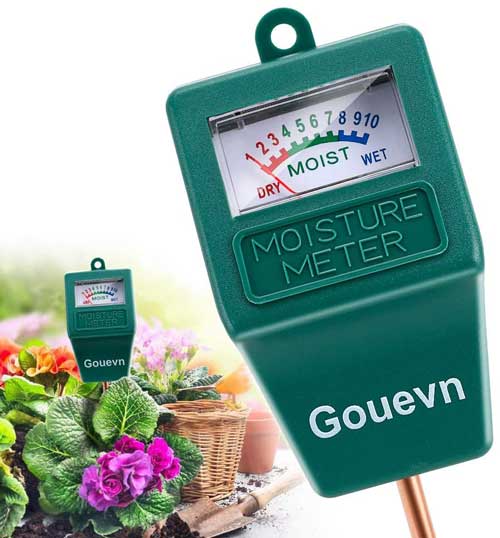Having plants in your home is a good way to beautify the surrounding. However, if your plants are not humid enough, they’re likely to develop yellow foliage, which will ultimately dry and fall off. The flower buds might also fall off as the leaves drop.
So, how can you keep your indoor plants humid?
- Identifying Your Plants’ Need for Humidity
- Increase Humidity without Humidifier
- Increase Humidity with Humidifier
- Interesting Ways to Increase Humidity
Identifying Your Plants’ Need for Humidity
Humidity plays a vital role in plant growth. Too much or too low humidity can negatively affect your houseplants. It’s, therefore, imperative to determine whether your plants are getting enough moisture and adopt measures to keep your indoor air humid.
Ideal humidity for plants range between 40-60%. However, some plant types prefer higher humidity. For example, Ferns particularly Nephrolepsis require higher levels of humidity around 80%.
Determine the Moisture Level in the Soil
If your indoor plants are not getting enough humidity, their roots will absorb more water from the ground, leaving the soil dry. Dry soil often indicates that your indoor air doesn’t have sufficient moisture:
Check the Soil Surface
By just looking at the surface, you can tell if the soil is dry. Dry soil often looks light brown, while moist soil appears darker. However, this technique is suitable for plants that need to be kept moist at all times, such as Boston ferns.
Use a Moisture Sensor
You can take advantage of technological advancement to determine your soil’s humidity using a moisture sensor. Place the probe slightly into the soil; the moisture sensor will display the result on a dial. Most moisture sensors will indicate the moisture levels in the soil via a color, as outlined below:
- Blue– the soil is too wet
- Green– moderate moisture levels
- Red– the soil is excessively dry
Poke Your Finger Into the soil
By sticking your finger into the soil, you will get a clear answer on the amount of moisture in your soil. This technique is better suited for plants in smaller pots because of your finger’s limited reach. Also, be extra careful not to damage the roots; try another pot area if you feel roots.
Lift the Plant Pot
When the soil is too dry, the pot will feel lighter than usual as the water adds a significant amount of weight to the soil. This method is particularly practical for plants in smaller pots. For plants in larger pots, you can tilt them on one side to gauge their weight.
- WARNING: Excessive and constantly wet soil can cause root rot.
Note: You will perfect this technique when you try it more often. Once you finish watering a plant, ensure to lift the pot to get an insight into its weight when the soil is moist.
Pay Close Attention to Slight Changes
Low humidity in plants leads to poor health, and it’s often the consequence of neglect. Checking your plants daily enables you to notice the smallest of the changes brought about by scarcity of moisture, for instance, brown leaf edges.
Know Your Plant Type
Various plants have different humidity requirements. The Spathiphyllum, commonly known as the Peace Lily, is a good example of an indoor plant that requires high humidity. This plant thrives in low-light, warm, and damp conditions.
On the contrary, plants like Succulents flourish in arid environments, despite their fleshy stems and leaves.
By knowing what your plants require, you will be able to place them in the appropriate spaces.
Humidity Without Humidifier
Group Similar Plants Together
In their natural habitat, plants naturally flock together based on their requirements. You should follow the same criteria when placing them in your indoor environment. Grouping plants that thrive in similar conditions eases your work; they also have comparable needs and are easy to care for.
Besides, as discussed earlier, some plants flourish in humid conditions while others thrive in drier environments. All houseplants release moisture into your indoor air through their leaves in a process known as transpiration. Consider grouping moisture lovers together; this will ensure that they naturally satisfy each other’s cravings by making the environment around them more humid.
If, for instance, you love aroids, you will want to group them in one area. The bigger the number of plants you group, the higher the humidity. Avoid placing succulents and cactus in such an area; these plants prefer low moisture conditions.
Humidity Tray for Plants
Canna and Elephants Ears are great examples of plants that love moisture but hate standing in overly wet soil, which is where pebble trays come in handy. Pebble or humidity trays are simply containers with water and small rocks, normally placed under houseplants. This is arguably the easiest way to keep your plants humid.
The trick here is to place the moisture-loving potted plant on top of the humidity tray. The tray enables the plant to obtain adequate humidity without getting its roots wet, preventing root rot.
Making your own pebble tray at home is remarkably easy:
- Find a shallow dish capable of accommodating some water
- Fill the dish with decorative rocks
- Add water into the dish while ensuring that the top of the rocks slightly sticks out above the liquid
- Check regularly and refill the tray when the need arises. Remember that the water level can drastically deplete in spaces with an AC.
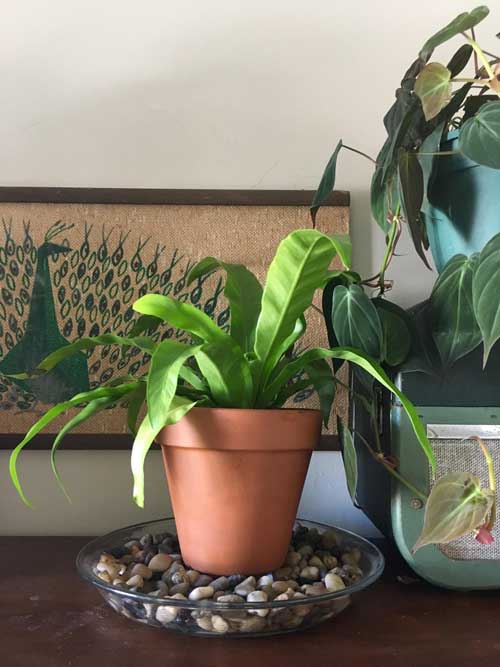
Tip: As the water evaporates, it keeps the plants humid. This, however, works best for plants requiring a slight increase in indoor moisture levels. If your plants require extreme humid conditions, then you should consider other ways.
Misting Your Plants
Most houseplants hail from the tropical jungles characterized by high humidity levels. Unfortunately, your indoor environment will not always be humid enough for your plants. The good news is that you can easily create a habitable environment for them to thrive.
Misting your indoor garden is among the most effective ways of fulfilling your plants’ humidity requirements without overwatering them.
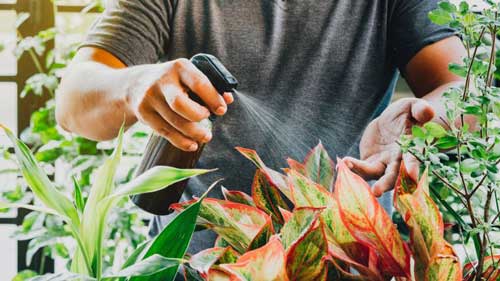
The Best Time to Mist your Plants
You wouldn’t want to retire to bed with wet clothes, right? This unspoken rule applies to your houseplants as well. Instead of misting your plants in the evening, start their day with perfect humidity. This gives the plants room to dry throughout the day and prevents mildew infestation.
How to Mist Your Plants
Misting your plants is a pretty straightforward process. Simply get a plant mister, fill it with filtered, lukewarm water and sprinkle your plants’ leaves.
Clean the Plants Before Misting
Misting and cleaning are two world-apart activities. When looking to clean your plants, you may wipe them down to remove the dust. You could also wash the plants under a shower. In addition to removing the dirt, cleaning your plants reduces the risk of dust mites and insect infestation.
Plants to Mist
Not all plants appreciate misting. Humidity lovers usually originate from tropical climates. By regularly misting them, you mimic their natural habitat and hence keep them healthy.
Plants that would appreciate regular misting include:
- ZZ Plants
- Ferns
- Lucky Bamboos
- Chinese Evergreen
- Croton
- Plea
- Orchids
- Peace lily
- Schefflera
- Philodendrons
Plants to avoid misting include:
- Succulents
- Cacti
- Piggyback
- African violets
Tip:
Some plants like the African Violets originate from humid environments. However, they feature velvety or hairy leaves; misting them could invite diseases or even lead to death.
Humidity With Humidifier
In winter, most people use air-drying heating systems that deprive their indoor air of much-needed humidity. As you suffer from dry skin, nosebleeds, and cracked lips, your indoor plants are not spared; the same weather conditions leave them limp and dull. This is because the plants are not getting enough moisture.
The most hassle-free and effective way to keep your plants humid is through a humidifier. Adding moisture into your indoor air with a humidifier is easy and doesn’t require much of your attention, especially when you choose the right unit.
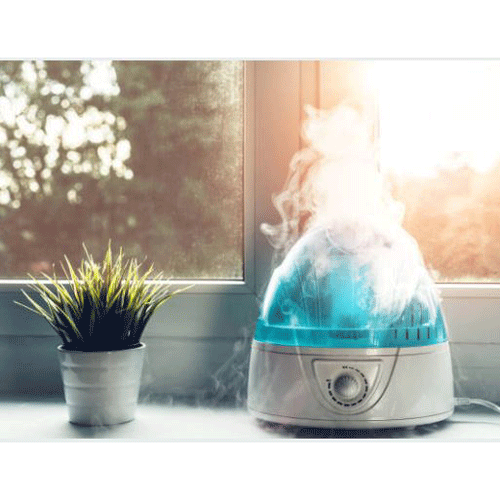
Here are some factors to consider when buying a humidifier for your plants:
Humidifier Type and Placement
When choosing a plant humidifier, remember that both warm mist and cool mist units work perfectly. However, a warm-mist humidifier might kill bacteria and require less cleaning than a cool-mist appliance. On the other hand, cool mist humidifiers are typically more energy efficient.
Whichever humidifier type you choose for your plants, remember that you can’t place the unit inches from your plants. Most humidifiers release heat into the environment, which can negatively affect your plants. If, for instance, you place the humidifier too close to the houseplant for a prolonged period, the heat could dry the plant up and eventually kill it.
It’s, therefore, imperative to be mindful of your appliance’s placement. This makes portable humidifiers ideal for plants as you can easily move and place them in a suitable position.
Room Size
The size of the room in which your plants are growing is a major consideration when purchasing a humidifier. Your prospective unit should be able to cover every inch of the room without struggling. If the room in question is 300 sq. ft. or less, consider acquiring a small-sized humidifier.
On the other hand, you will need a medium-sized humidifier for rooms measuring 350 to 400 sq. ft. For rooms 550 sq. ft., you will require a large-sized unit. Ideally, choose a humidifier capable of maintaining a 60% humidity level to keep your plants happy.
Noise Level
If your grow room is close to your bedroom, you might want a humidifier with a low noise output. Even the smallest humidifiers produce sound as they use fans to disperse moisture into your indoor environment. Luckily, you can find a humidifier whose noise level is below a whisper.
Water Tank
The main objective of using a humidifier is to create a moist environment for your plants steadily. You will want to select a unit capable of dispensing mist continuously, which is where a humidifier with a large capacity tank comes in handy. Such a unit will save you the hassle of refilling the reservoir too often.
Reminder: Using a humidifier is an effective way of keeping your plants humid. The appliance, however, calls for a few maintenance chores. For instance, you need to clean the unit frequently to avoid bacterial buildup. For hygiene purposes, you will also want to change the filters regularly.
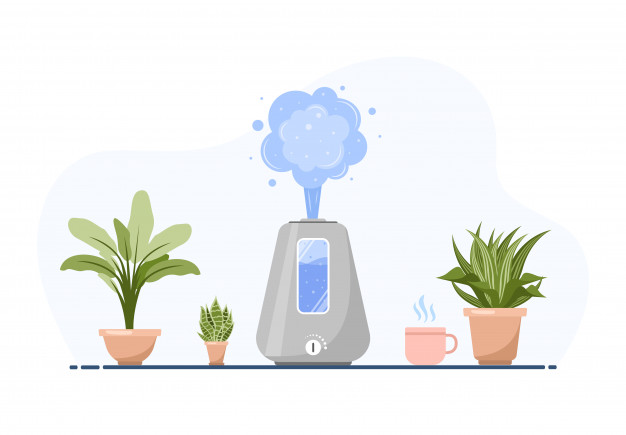
Make use of the Humidity in Your Bathroom
Look at those orchids in your home; imagine how they would relish that excess moisture in your bathroom. While an overly humid bathroom is often a nuisance for homeowners, it could create a sanctuary for your humid-loving plants.
Placing moisture lovers in your bathroom comes with numerous benefits. For instance, the plants will absorb the excess moisture and hence eliminate the chances of mold growth on your bathtub, toilet, ceilings, and walls. Also, the plants could well serve as décor for your restroom.
However, not all plants will thrive in the bathroom conditions:
- If you have adequate natural lighting in your bathroom, you have a wide assortment of plants from which you can choose. Some of the plants that will do well in a well-lit bathroom include Gardenias, Asparagus Ferns, and Azaleas, to name a few.
- Bathrooms with minimal natural lighting can host Bamboo, Aloe Vera, Spider Plants, Boston Ferns, and Orchids.
- If you prefer long, hot showers, you require a plant that can survive while solving the humidity issues in your home. Plants like Bamboo, English Ivy, and Chinese Evergreen absorb humidity at an extremely high rate. With one or a couple of these plants, you will walk into a dry bathroom a couple of hours after taking a steaming shower.
Tip: Remember to provide a barrier for plants like bamboo to stunt their growth as they tend to grow quickly.
Create a Terrarium Environment
Terrarium environments are typically closed or semi-open environments. Certain plants, particularly tropical-based plants, thrive well in these conditions. You can create a simple terrarium environment using a clear plastic bag.
Take-Home
Indoor plants bring numerous benefits that go beyond interior landscaping. Plants breathe like humans but in reverse. They take in carbon dioxide and release fresh oxygen into your indoor environment. Houseplants boast a calming effect on your mood; interacting with plants in various ways like smelling, touching, and taking care of them can positively affect your sympathetic nervous system and blood pressure, allowing you to feel relaxed and calmer.
Keeping houseplants comes with responsibilities, including ensuring that your indoor air is sufficiently moist for optimal plant growth. But how do you know if your houseplants are getting enough humidity if you don’t pay attention? You will want to be on the lookout for telltale signs of low humidity, and your plants’ behavior is the best indicator.
The commonest sign is brown and crispy leaf tips. The leaves may also turn yellow, and the entire plant could wilt and droop. If you notice any of these signs, you will want to increase the moisture levels in your indoor environment. This is easily achieved with a humidifier, pebble trays, misting your plants, or grouping humid-loving houseplants together.
Remember that most indoor plants originate from tropical jungles. If these plants are exposed to dry environments, they might not survive. It’s, therefore, important to provide a humid atmosphere to mimic their natural habitat.

